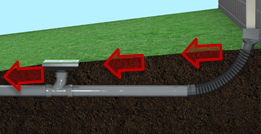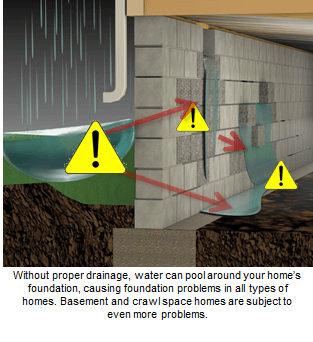
The key is to keep an eye on what’s happening with moisture and heat, inside and outside your home.
How do I keep unwanted moisture out of my home, basement or crawl space?
-
Check the whole perimeter of your home to be sure that water is draining away from your foundation. Soil should slope away from the house at least one inch per foot for at least six feet to ensure proper drainage. Even a small amount of accumulated water can start to compromise your foundation if it stays there too long.
- Rain water is great for lawns and gardens, but tough on the structural elements of your home. Before it gets too cold and wet outside, inspect all of your gutters, downspouts and leader pipes. Use a garden trowel to scoop out debris and flush the downspouts with a bucket of water. If you find any blocks in the downspouts, you can easily clear them with a standard plumbers snake.
- Water can also sneak into your home through curled or cracked shingles or places where seals and caulking have shrunk or cracked with age. Any place where an architectural element like a window, door or chimney breaks another surface like roofing or siding, make sure all the seals are complete and tight. A couple of cheap tubes of caulking can save you thousands later on.
- Condensation can cause as much trouble as standing water if it isn’t managed properly. Check around appliances that generate heat to be sure that condensation isn’t building up behind joints and vents. Discoloration on wall or flooring materials could mean that hidden moisture could be trapped nearby that can lead to unhealthy mold, mildew, air quality or even structural problems.
How do I keep my home warm during fall and winter?
- Replacing damaged or missing weather stripping is the most effective and least expensive way to keep your energy dollars from literally ”going out the window.” In addition to checking the stripping around doors and windows, also inspect wall or attic penetrations where satellite, cable or other utility services enter your home and make sure they’re all properly sealed and tight.
- Believe it or not, ceiling fans can actually help you save big on fall and winter energy bills. In just a few minutes you can quickly flip the reverse setting on every fan motor in the house so that they’ll push warm air back down into the room when it rises. This will allow you to use a more conservative setting on your thermostat and cycle the heater less often.
- 120 degrees is the recommended setting for your water heater. Higher settings will result in wasted energy dollars since much of the additional heat escapes before the water reaches your tap. Installing a timer that keeps the water heater off during hours when people are normally away from home or asleep can save you a lot of money.
- Put technology to work for you to lower your bills. Home automation has come a long way in the last few years and costs have come down on affordable options for replacing inefficient mechanical controls with digital ones that optimize energy and appliance use. This includes programmable thermostats and localized demand water heating options.
What’s the best way to prevent foundation problems, fire hazards and other problems from occurring inside my home?
Fall is a great time for a routine inspection of smoke detectors, CO detectors and fire extinguishers. Follow the manufacturer’s testing instructions, make sure that batteries are fresh and that all the parts are clean and in good working order. It’s also a good idea to make sure that a working fire extinguisher thats rated for all fire types (A-B-C) is in easy reach on every floor.
- Before firing up heating sources in your home that have been idle for a few months, it’s a good idea to have them professionally inspected. Watch out for clogs and buildup in ducts, vents and drains, so that heat can safely go where it’s supposed to. Make sure that filters are clean and clear soot and creosote from wood stoves and fireplaces.
- Small cracks in walls, footings, sidewalks and driveways are often harmless and can result from normal settling of construction materials. If cracks are spreading and changing, however, this could be a sign of underlying foundation problems or hidden water damage. The arrival of cold, wet weather can aggravate these issues if they’re ignored and lead to serious and costly structural damage.
- Monitoring your foundation for cracks and inspecting walls and floors carefully for signs of mold and mildew is more than just a smart preventive maintenance tactic – it’s also a health issue that can affect the air quality throughout your home. Musty odors, new surface discoloration or chronic coughing and runny noses could be a sign of moisture or mold problems that need attention.
Between now and Halloween we’ll still enjoy enough comfortable weather to make it both easy and pleasant to get outdoors and get ahead on some of these important preventive measures.
The great news is that none of them have to be long, complicated or expensive. When signs of trouble turn up, it’s a good idea to have a trusted, qualified repair company take a look so that you don’t run into more expensive problems later on. If you make it a routine to do some of these seasonal tune-ups, your home will continue to give you affordable comfort all year ’round.


 Fall is a great time for a routine inspection of smoke detectors, CO detectors and fire extinguishers. Follow the manufacturer’s testing instructions, make sure that batteries are fresh and that all the parts are clean and in good working order. It’s also a good idea to make sure that a working fire extinguisher thats rated for all fire types (A-B-C) is in easy reach on every floor.
Fall is a great time for a routine inspection of smoke detectors, CO detectors and fire extinguishers. Follow the manufacturer’s testing instructions, make sure that batteries are fresh and that all the parts are clean and in good working order. It’s also a good idea to make sure that a working fire extinguisher thats rated for all fire types (A-B-C) is in easy reach on every floor.